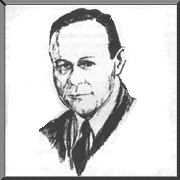 Charles
Richard Drew, was born in Washington D.C. on June 3,
1904 and was the eldest of five children. His father was a carpet
layer and his mother was a school teacher. As a young man, Charles
was an excellent student and a great athlete in sports like swimming,
football, basketball, baseball, and track. He attended Amherst
College in Massachusetts on an athletic scholarship.
Charles
Richard Drew, was born in Washington D.C. on June 3,
1904 and was the eldest of five children. His father was a carpet
layer and his mother was a school teacher. As a young man, Charles
was an excellent student and a great athlete in sports like swimming,
football, basketball, baseball, and track. He attended Amherst
College in Massachusetts on an athletic scholarship.
Upon graduation form Amherst with highest honors, he accepted teaching responsibilities at Morgan State College in Baltimore, Maryland as a professor in both chemistry and biology. Charles' goal was to understand the human body. Two years later he applied to the Howard University School of Medicine, but was rejected. He immediately applied to McGill University and was accepted. His academic achievements continued to help him gain scholarships to fund his education. There he studied medicine and graduated in 1933, receiving his MD and Master of Surgery degrees. Charles went on to intern at the Royal Victoria Hospital and did his residency at Montreal General Hospital. He continued to do research on blood and completed his residency in surgery in 1935.
Charles left Montreal and accepted a two-year Rockefeller fellowship in surgery at the Presbyterian Hospital in New York City and a General Education Board Fellow in Surgery at Columbia University. Here Charles worked on blood research with Dr. John Scudder and Dr. E.H.L. Corwin and developed a process where blood plasma could be processed and preserved. The goal was to ship blood plasma to distant places to be used for transfusions in saving lives.
By 1938, Charles set up a blood plasma system and by 1939, he set up a blood bank at the Columbia Medical Center. He made a breakthrough discovery that blood plasma could replace whole blood, which deteriorated in a few days in storage. This discovery played a major role during World War II where many countries experienced extreme casualties. Because of his findings, Charles was appointed to a position with the American Red Cross Donor Service and was named director of the first Red Cross project to collect and bank the blood of 100,000 donors.
Upon his death on March 31, 1950 at age 45, Charles Drew wrote numerous articles on hematology for medical journals and was recognized internationally by scientists as one of the world's leading hematologists.
Page created by: Doris Tong
Hudson, Gossie (1975). American Black Scientists and Inventors. Washington, D.C.: National Science Teachers Association.
Berman, Peter M. and Mort N. Bergman (1964). The Chronological History of the Negro in America. Chicago: Harper and Row.